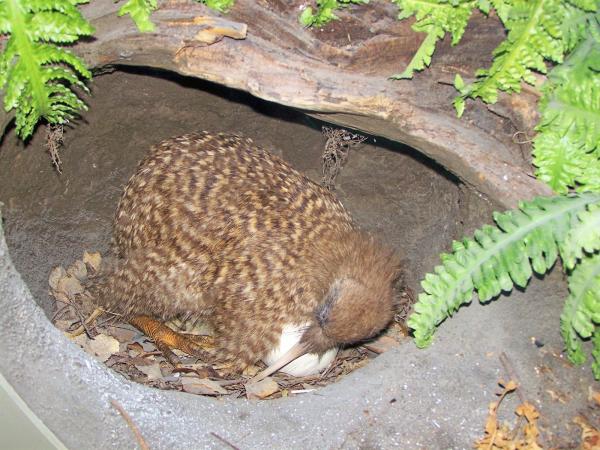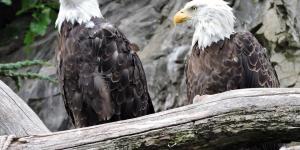Where Do Kiwis Live? - Habitat and Distribution


The geographic isolation of the islands comprising New Zealand means that species have not migrated as much as many other places. 90% of its endemic flora and fauna can only be found on this continent and has flourished for millions of years. New Zealand still has 25% of its original rain forest, which is why it's such a prolific area for endemic species. Some of its most interesting fauna is its avian species, especially their flightless birds. The kiwi is one of them, but you can also find other specimens such as the colorful Tahake.
If you are wondering where do kiwis live? and what their habitat is like, AnimalWised as the answers. Read on to Find out more about the bird that gives Zealanders their unofficial nickname.
The declining population of kiwi birds
The kiwi population around 80 years ago equaled around 5 million birds. These have plummeted to as low as fifty thousand due to the introduction of foreign predators. This is the main reason the kiwi bird has become endangered. Depending on the type of kiwi bird species, the location varies.
Although kiwis live in New Zealand, this is encompasses a large are and there are other factors to consider when wondering where do kiwi birds live? Let's take a look a the different types of species and their locations before we get into further detail:
- Brown kiwi: endemic to North Island of New Zealand, it ranges in color from russet red to black and occasionally albino. Sub-species include the Coromandel brown, the Easter brown and the Western brown.
- Great Spotted kiwi: endemic to the South Island, it has fallen in number from 30,000 to around 10,000. It was even thought to be totally extinct in the 1980s.
- Tokoeka kiwi: there are several subspecies which can be categorized according to their area. The Haast is also found in the South Island. It has fallen in numbers from 6,000 to around 350. Though the Stuart Island Tokoeka currently boasts a population of 13.000, it is estimated that in 2030 the population will decline to barely 9,000 kiwis. The Fiordland Tokoeka kiwi are endemic to the beautiful region of Fiordland. There are currently 12,500 of them in the area.
- Little Spotted kiwi: they were found on both islands including predator free outlying islands. There are currently only 1500 birds of this subspecies.
- Okarito kiwi: they have dropped to 350 from 3,000 and is found in on certain islands that form the South Island.

Where do kiwi birds live?
In their natural habitat, kiwis don't need to survive in pristine, native forests. They are found in scrub and rough farmlands as well as exotic forest plantations, other forests, snowy tussocks, sand dunes, and mangroves. They prefer places with wetland vegetation and where trees run down to the edge of the river.
As they are soil feeders, kiwis like to go directly to the ground rather than negotiating the thick leaf litter of the forest. They avoid hard, compacted ground.
Kiwis are chiefly nocturnal animals and commonly forest dwellers. They make dens or nest in burrows, hollow logs or parts of dense vegetation. These are only some of the reasons why kiwis as pets are not the best idea. In the wild, knowing where kiwi birds live depends on some specific factors. One of the most important is the type of kiwi bird.
Great spotted kiwi
This is the largest of the kiwi birds, the great spotted kiwi is eighteen inches tall and 3.3 kg in weight, although the male great spotted kiwi is lighter at 2.4–2.5 kg. This type of kiwi is brownish in color.
There are around 20,000 of these left in the Southern Island of New Zealand. Great spotted kiwis can be seen in the wild in three main areas:
- Southern Alps: all the way from beautiful Arthur's Pass to Lake Sumner, these kiwis are still going strong.
- Nelson Lakes National Park: from North-West Nelson to the Bullet river, the great spotted kiwi has been sighted many times recently and seems to be breeding, making this sub-species' population stable. A settlement on Lake Rotoiti Mainland island has also been established recently.
- Northern-West Coast: the Paparoa range is also home to this kiwi and is undergoing a conservation movement to protect the kiwis from predators, known as operation nest egg.

Little spotted kiwi
This species is small in size at 1.3 kg weight and 9.8 inches in height. This species of kiwi bird is found in one of the most southern islands of New Zealand: the Kapiti Islands. A total of around 1,400 are estimated to be alive. However, small populations also live in the northern islands of Tiritiri Matangi, close to Auckland, Mercury Island, Chalky Island and Motiuhe. A small number of little spotted kiwis were also moved from the Kapiti Island to Anchor Island in Fiordland in 2015.

Okarito kiwi
This is a species also known as Rowi. It was recognized as a distinct category in the 1990s. Small in size, this kiwi bird is grayish in color and lays eggs at the rate of 3 in a single season, each in a distinct burrow, making an average total of around 80 new Rowi eggs per season. The Okarito is found in Southern New Zealand, more specifically in the following areas:
- Marlborough sound: the Okarito is seen in specific islands of Marlborough sound.
- Okarito forest: around the debris of the lowland forest, the Rowi lives in a very small area that comprises this forest.
- South Westland: around the area of Mount Aspiring National Park and Franz Joseph glacier, Rowi kiwis can barely be seen outside their Sanctuaries.

Brown kiwi
This kiwi lives in the North Island. It is the most common type of kiwi as it is the sub-species that breeds fastest. It lives in the lowland and the coastal forests in the North Island, as well as some sub-apline areas, depending on the sub-type:
- Coromandel Brown: the Coromandel peninsula is home to 1000 brown kiwis. The Coromandel kiwi collective is currently doing a great job to maintain their habitats, around Te Kauae, Mahakiaru Forest and Te Moata among other places around the peninsula.
- Northland Brown: they currently live around shrubland and forest areas between Awanui and Bryndernwyns. They can also be seen on the Bay of Islands and Hauraki Gulf.
- Western Brown: according to the Department of Conservation of New Zealand, the main areas where these creatures live is around Taranaki, the north of the Ruhaine
- Eastern Brown: the Bay of Plenty, Howke's bay and most of the East coast is home to this type of kiwi bird.

Tokoeoka kiwi
Also known as Southern brown kiwi, is a same sized bird as the great spotted kiwi, and is found on New Zealand's east coast. This species resides in elevated regions, unlike other categories of kiwi. Only three kiwi species of the southern brown genre exist in New Zealand at present. There are three types of Tokoeka which, in total, comprise the biggest number of kiwi species in New Zealand.
Let's take a look at where we can find each type of Tokoeka kiwi:
- Raikiura Tokoeka: also known as Stewart Island Tokoeka, you can probably guess where to find them. Although the population in Mason Bay is declining, this kiwi boats a total of 13,000 taxa, which usually lives around dunes, the bush or tussock grass.
- Fiordland Tokoeka: the vast area of Fiordland, which unites sea and mountain is the perfect habitat for this type of kiwi, although you may only get to see them in the heights of the Murchison Mountains, near Te Anau; which is also home to the only surviving Tahake colony.
- Haast Tokoeka: this kiwi loves living in the mountains, though there is only a population of 400. As the name suggests, they live in the high ranges of Haast, Olivine and Selborne right by the Southern Alps; as well as Arawhata, Waiatoto, Okuru and Haast valleys, all on the Southern West Coast.

Protecting the kiwi's habitat
The kiwi has become a flagship species for conservation and is often used as a measure for the state of our natural environment and the outcome and value of community conservation projects. The threats to the kiwi include habitat modification, fragmentation, declining population and predators (mainly stoats, possums, and rats). Currently, there are 68,000 kiwi left in New Zealand, with a loss at the rate of 20 per week every year, according to some estimates.
Combined community groups actively protect 230,000 ha designated for the kiwi across New Zealand. The land is managed to protect the species from wild predator populations which include predator-free islands. The country's delicate ecosystem is one of the reasons they have such strict customs laws to prevent invasive species.
As it manages one-third of the land mass of New Zealand, including 5 kiwi sanctuaries, the Department of Conservation has protected the kiwi habitat. Community-based kiwi conservation groups are also protecting the habitat as are private landowners. Creating a pest and predator-free sanctuaries benefit the native plants and animals of the country too, besides the kiwi. According to the Department of Conservation, the kiwi is one of 7 indicator species in New Zealand. If the kiwi is doing well, his means so are other species.
If you want to know some other types of animals which need protected, you can check out this video on endangered species in Mexico:

If you want to read similar articles to Where Do Kiwis Live? - Habitat and Distribution, we recommend you visit our Facts about the animal kingdom category.











